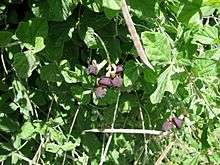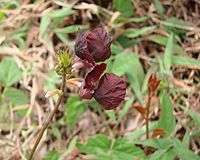Macroptilium atropurpureum
| Macroptilium atropurpureum | |
|---|---|
 | |
| Leaves, Flowers, and Pods. | |
| Scientific classification | |
| Kingdom: | Plantae |
| (unranked): | Angiosperms |
| (unranked): | Eudicots |
| (unranked): | Rosids |
| Order: | Fabales |
| Family: | Fabaceae |
| Subfamily: | Faboideae |
| Tribe: | Phaseoleae |
| Subtribe: | Phaseolinae |
| Genus: | Macroptilium |
| Species: | M. atropurpureum |
| Binomial name | |
| Macroptilium atropurpureum (DC.) Urb. | |
Macroptilium atropurpureum, commonly referred to as purple bush-bean,[1] or siratro is a perennial legume recognized by its climbing dense green vines and deep purple flowers.[2] The plant is indigenous to the tropical and subtropical regions of North, Central and South America, as far north as Texas in the USA and as far south as Peru and Brazil, but it can be found in many tropical regions around the world. Rich in protein, Macroptilium atropurpureum is commonly used for cattle pastures intercropped with grass, used in hay, or as a ground cover to prevent soil erosion and to improve soil quality.[3]
Description

Macroptilium atropurpureum is a tropical herbaceous dicot belonging to the ‘Fabaceae’ family. Macroptilium atropurpureum rapidly develops dense dark hairy green vines approximately 5 mm in diameter,[4] until it reaches its mature size of approximately 120 centimetres.[5] The vines have bright green trifoliolate leaves, which are approximately 2-7 centimetres long with smooth hairs on the underside.[6] Flowers are dark reddish purple. The seeds are small brown peas with a white spot, found in the plant's pods which hang on the vines in bunches of about 5-10.[7] In weather and soil conditions favourable to the plant, stem nodes close to the soil may root, enabling vegetative propagation of the plant.[8] Macroptilium atropurpureum forms a deep swollen taproot up to 2 centimetres in diameter.[9]
History and Geography
'Macroptilium atropurpureum' is also commonly referred to as '‘Siratro/Aztec'’ (modified races to improve nematode resistance and reduce rust sensitivity respectively) '‘atro’', '’purple bush-bean'’ (a common English term for the species), '‘Purpurbohne’' (a common German term for the species), or ‘'Conchito'’ (a common Spanish name for the species).[10] It has a short lifespan, but a high density, with a minimum of 1200 plants per acre and a maximum of 1700 plants per acre when it is in season and free to grow.[11] Macroptilium atropurpureum is native to Central and South America as well as the Caribbean Islands[12] and has been known to grow in some regions of southern North America, including Mexico[13] and the USA in states such as Arizona, Texas, Florida, and Hawaii,[14] as well as coastal regions in Queensland and New South Wales, Australia,[15] and scattered regions across Africa.[16] Its historical use has been to serve as pasture for domesticated livestock, and was the first tropical pasture improved by breeding. Performed in Australia in 1960s, native Macroptilium atropurpureum was bred to resist nematodes in its roots, which created a modified species known as ‘'Siratro'’, which developed a rust sensitivity, so ‘'aztec'’ was developed to counter the arisen problem in 19945. On indigenous North and South American farms where Macroptilium atropurpureum was available, it would often be used as a ground cover during dry seasons1 to take advantage of the nitrogen fixation abilities the legume has- this prevented soil erosion and acted as an organic fertilizer.[17]
Growing Conditions
One of the most strategic advantages to Macroptilium atropurpureum is its ability to grow and prosper in varied soil types. It is propagated naturally by legumes bursting and sending seeds forcefully into the ground. Growing season varies geographically, but typically will be in the spring and summer months. It can be grown in soils that are course and fine, as well as all variations between.[18] Primarily it is grown on pasture fields interbred with a grass to retain the soil and prevent erosion.[19] Macroptilium atropurpureum is often found by roadsides, in vegetation around waterways and coastal regions, and on disturbed ground.[20] In terms of acidity, Macroptilium atropurpureum can grow in most soils. It can survive in soils with a pH level as low as 5.0 and as high as 8.0. It can also survive in most temperatures, requiring a minimum temperature of 23 degrees Fahrenheit, and has an average salinity and shade tolerance. Macroptilium atropurpureum requires an average precipitation of between 15 – 111 cm.[21] Macroptilium atropurpureum has been tested on several occasions to find additional benefits. When used on a cow pasture intercropped with traditional grass in Australia, it improved milk yield by 2 kg per day. It also improved yields from domestic animals such as goats in Kenya, Zambia, Tanzania, and other African countries.[22] Because of its nitrogen fixing abilities as a legume, Macroptilium atropurpureum acts as an efficient source of protein for animals when intercropped with grass on the pastures of subsistence farms and low-income farms, especially in Central and South America.[23] In addition to improving yield, Macroptilium atropurpureum acts as a ground cover for farmers who need a nutrient-rich ground cover to counter soil erosion and improve soil quality.[24]
Uses, Impacts and Benefits
Macroptilium atropurpureum’s primary beneficial use is for pastures. It is well suited for grazing, both long and short term, when intercropped in fields with grass.[25] This method is known to improve livestock yields.[26] Alternatively, it can be used in combination with grass to create protein-rich hay, or used for soil conservation. To improve soil, Macroptilium atropurpureum can be planted to improve nutrient-soil quality before planting something else. Once growing season is over, Macroptilium atropurpureum or its trimmings ideally will be left on the farmers’ field to act as a fallow (no work necessary) cover crop to prevent soil erosion. One problem with this method is that some seeds may be left in the soil, as the vine will reproduce on its own, dispersing seeds randomly into the soil. Macroptilium atropurpureum is very adaptable to soil, drought resistant, has good N fixation, and has a high palatability to domesticated animals.[27]
Negative Impacts and Limitations
Macroptilium atropurpureum is considered a pest plant under some local government law, including some small local governments in Australia. It has negative effects on native shrubs, grasses and young trees by smothering them under its dense vines and not allowing them enough sunlight or soil nutrients to grow.[28] Macroptilium atropurpureum also has a few limitations which include its intolerance to poor water drainage, its declining nutritional value after continued grazing, and its susceptibility to leaf disease. In periods of heavy rainfall, Macroptilium atropurpureum is susceptible to '‘foliar blight’' (infection from a pathogenic organism).[29]
Nutritional Information
Macroptilium atropurpureum is primarily grown for its high protein content, with protein accounting for approximately 16 percent of the plants '‘dry matter’' (the percentage of a plant that remains in weight when dried out, accounting for approximately 25 percent of a Macroptilium atropurpureum vine). Primary Amino Acids include Aspartic acid and Proline. Macroptilium atropurpureum also is a good source of Calcium, Potassium, and Manganese.[30]
Practical Information
In growth, Macroptilium atropurpureum sprawls outward to cover the ground. By doing so, it acts as an efficient weed suppressor, as it competes with weeds for soil nutrients, and smothers them under its vines. Planting Macroptilium atropurpureum on a weed-infested field will reduce and kill weed populations, and improve the soil at the same time. Macroptilium atropurpureum fixes nitrogen from 55 to 175 kg N/ha/year.[31] It improves milk and cattle yield by small percentages when used on a cattle pasture. When Macroptilium atropurpureum was used as living mulch in banana plantations, fruit yields improved.[32] Primarily it should be used for a simple ground covering in order to control erosion and for re-vegetation of non-fertile land.
References
- ↑ Macroptilium atropurpureum. (n.d.). Tropical Forages Factsheet. Retrieved from http://www.tropicalforages.info/key/Forages/Media/Html/Macroptilium_atropurpureum.htm
- ↑ Macroptilium atropurpureum. (n.d.). United States Department of Agriculture. Retrieved from http://plants.usda.gov/core/profile?symbol=MAAT80
- ↑ Macroptilium atropurpureum. (n.d.). Tropical Forages Factsheet. Retrieved from http://www.tropicalforages.info/key/Forages/Media/Html/Macroptilium_atropurpureum.htm
- ↑ Macroptilium atropurpureum Fact Sheet. (2012). The State of Queensland, Department of Agriculture,Fisheries and Forestry. Retrieved from http://www.daff.qld.gov.au/__data/assets/pdf_file/0003/65289/IPA-Siratro-PP93.pdf
- ↑ Macroptilium atropurpureum. (n.d.). United States Department of Agriculture. Retrieved from http://plants.usda.gov/core/profile?symbol=MAAT80
- ↑ Macroptilium atropurpureum. (n.d.). Queensland Government Department of Agriculture, Fisheries and Forestry. Retrieved from http://www.daff.qld.gov.au/plants/weeds-pest-animals-ants/weeds/a-z-listing-of-weeds/photo-guide-to-weeds/siratro
- ↑ Macroptilium atropurpureum Fact Sheet. (2012). The State of Queensland, Department of Agriculture, Fisheries and Forestry. Retrieved from http://www.daff.qld.gov.au/__data/assets/pdf_file/0003/65289/IPA-Siratro-PP93.pdf
- ↑ Macroptilium atropurpureum. (n.d.). United States Department of Agriculture. Retrieved from http://plants.usda.gov/core/profile?symbol=MAAT80
- ↑ Siratro (Macroptilium atropurpureum) dry matter facts (n.d.). Animal Feed Resources Information System. Retrieved from http://www.feedipedia.org/node/12602
- ↑ Macroptilium atropurpureum. (n.d.). Tropical Forages Factsheet. Retrieved from http://www.tropicalforages.info/key/Forages/Media/Html/Macroptilium_atropurpureum.htm
- ↑ Macroptilium atropurpureum. (n.d.). United States Department of Agriculture. Retrieved from http://plants.usda.gov/core/profile?symbol=MAAT80
- ↑ Siratro (Macroptilium atropurpureum) dry matter facts (n.d.). Animal Feed Resources Information System. Retrieved from http://www.feedipedia.org/node/12602
- ↑ Macroptilium atropurpureum. (n.d.). Tropical Forages Factsheet. Retrieved from http://www.tropicalforages.info/key/Forages/Media/Html/Macroptilium_atropurpureum.htm
- ↑ Macroptilium atropurpureum. (n.d.). United States Department of Agriculture. Retrieved from http://plants.usda.gov/core/profile?symbol=MAAT80
- ↑ Macroptilium atropurpureum. (n.d.). Queensland Government Department of Agriculture, Fisheries and Forestry. Retrieved from http://www.daff.qld.gov.au/plants/weeds-pest-animals-ants/weeds/a-z-listing-of-weeds/photo-guide-to-weeds/siratro
- ↑ Siratro (Macroptilium atropurpureum) dry matter facts (n.d.). Animal Feed Resources Information System. Retrieved from http://www.feedipedia.org/node/12602
- ↑ A. Angus, A. Lee, M. Lum, M. Shehayeb, R. Hessabi, N. Fujishige, S. Yerrapragada, S. Kano, N. Song, P. Yang, P. Estrada de los Santos, S. de Faria, F. Dakora, G. Weinstock and A. Hirsch (2009). Nitrogen-fixing bacteria communities occurring in soils under different uses in the Western Amazon Region as indicated by nodulation of siratro (Macroptilium atropurpureum). An International Journal on Plant-Soil Relationships, 1, 127-145.
- ↑ Macroptilium atropurpureum. (n.d.). United States Department of Agriculture. Retrieved from http://plants.usda.gov/core/profile?symbol=MAAT80
- ↑ Macroptilium atropurpureum. (n.d.). Tropical Forages Factsheet. Retrieved from http://www.tropicalforages.info/key/Forages/Media/Html/Macroptilium_atropurpureum.htm
- ↑ Macroptilium atropurpureum. (n.d.). Queensland Government Department of Agriculture, Fisheries and Forestry. Retrieved from http://www.daff.qld.gov.au/plants/weeds-pest-animals-ants/weeds/a-z-listing-of-weeds/photo-guide-to-weeds/siratro
- ↑ Macroptilium atropurpureum. (n.d.). United States Department of Agriculture. Retrieved from http://plants.usda.gov/core/profile?symbol=MAAT80
- ↑ Siratro (Macroptilium atropurpureum) dry matter facts (n.d.). Animal Feed Resources Information System. Retrieved from http://www.feedipedia.org/node/12602
- ↑ A. Angus, A. Lee, M. Lum, M. Shehayeb, R. Hessabi, N. Fujishige, S. Yerrapragada, S. Kano, N. Song, P. Yang, P. Estrada de los Santos, S. de Faria, F. Dakora, G. Weinstock and A. Hirsch (2009). Nitrogen-fixing bacteria communities occurring in soils under different uses in the Western Amazon Region as indicated by nodulation of siratro (Macroptilium atropurpureum). An International Journal on Plant-Soil Relationships, 1, 127-145.
- ↑ Macroptilium atropurpureum. (n.d.). Tropical Forages Factsheet. Retrieved from http://www.tropicalforages.info/key/Forages/Media/Html/Macroptilium_atropurpureum.htm
- ↑ Macroptilium atropurpureum. (n.d.). Tropical Forages Factsheet. Retrieved from http://www.tropicalforages.info/key/Forages/Media/Html/Macroptilium_atropurpureum.htm
- ↑ Siratro (Macroptilium atropurpureum) dry matter facts (n.d.). Animal Feed Resources Information System. Retrieved from http://www.feedipedia.org/node/12602
- ↑ 1. Macroptilium atropurpureum. (n.d.). Tropical Forages Factsheet. Retrieved from http://www.tropicalforages.info/key/Forages/Media/Html/Macroptilium_atropurpureum.htm
- ↑ Macroptilium atropurpureum Fact Sheet. (2012). The State of Queensland, Department of Agriculture, Fisheries and Forestry. Retrieved from http://www.daff.qld.gov.au/__data/assets/pdf_file/0003/65289/IPA-Siratro-PP93.pdf
- ↑ Macroptilium atropurpureum. (n.d.). Tropical Forages Factsheet. Retrieved from http://www.tropicalforages.info/key/Forages/Media/Html/Macroptilium_atropurpureum.htm
- ↑ Siratro (Macroptilium atropurpureum) dry matter facts (n.d.). Animal Feed Resources Information System. Retrieved from http://www.feedipedia.org/node/12602
- ↑ Macroptilium atropurpureum (DC) Urb. (n.d.). Food and Agricultural Organization of the United Nations. Retrieved from http://www.fao.org/ag/agp/AGPC/doc/gbase/data/pf000049.htm
- ↑ Siratro (Macroptilium atropurpureum) dry matter facts (n.d.). Animal Feed Resources Information System. Retrieved from http://www.feedipedia.org/node/12602
| Wikimedia Commons has media related to Macroptilium atropurpureum. |